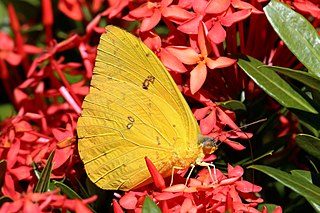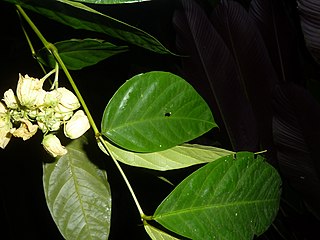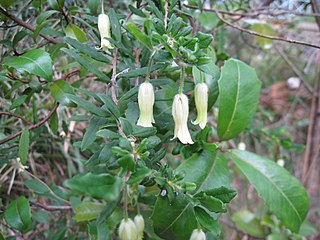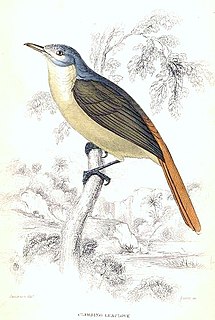
Ayrton Senna da Silva was a Brazilian racing driver who won the Formula One World Drivers' Championship in 1988, 1990 and 1991. Senna is one of three Formula One drivers from Brazil to win the World Championship and won 41 Grands Prix and 65 pole positions, with the latter being the record until 2006. He died in an accident leading the 1994 San Marino Grand Prix driving for the Williams team.

Phoebis sennae, the cloudless sulphur or cloudless giant sulphur, is a mid-sized butterfly in the family Pieridae found in the Americas. There are several similar species such as the yellow angled-sulphur, which has angled wings, statira sulphur, and other sulphurs, which are much smaller.

Senna, the sennas, is a large genus of flowering plants in the legume family. This diverse genus is native throughout the tropics, with a small number of species in temperate regions. The number of species is estimated to be from about 260 to 350. The type species for the genus is Senna alexandrina. About 50 species of Senna are known in cultivation.

Millettia laurentii is a legume tree from Africa and native to the Republic of Congo, the Democratic Republic of Congo, Cameroon, Gabon and Equatorial Guinea. The species is listed as "endangered" in the IUCN Red List, principally due to destruction of its habitat and over-exploitation for timber. Wenge, a dark colored wood, is the product of Millettia laurentii. Other names sometimes used for wenge include African rosewood (ambiguous), faux ebony, dikela, mibotu, bokonge, and awong. The wood's distinctive color is standardised as a "wenge" color in many systems.

Phayre's leaf monkey, also known as Phayre's langur, is a species of lutung native to South and Southeast Asia, namely India, Bangladesh and Myanmar. Populations from further east are now thought to belong to other species. It is listed as Endangered on the IUCN Red List and is threatened by hunting and loss of habitat. The species epithet commemorates Arthur Purves Phayre.

Senna caudata is a flowering plant species in the legume family (Fabaceae). This plant is found only in Costa Rica and Panama.
Senna domingensis is a flowering plant species in the legume family (Fabaceae). It is a threatened species, found in Cuba, the Dominican Republic, and Haiti.
Senna socotrana is a species of flowering plant in the family Fabaceae, that is endemic to Yemen.
Senna trolliiflora is a flowering plant species in the legume family (Fabaceae). It is a near-threatened species found only in Ecuador. Its natural habitat is subtropical or tropical moist lowland forests.

Billardiera scandens, commonly known as apple berry or apple dumpling, is a small shrub or twining plant of the Pittosporaceae family which occurs in forests in the coastal and tableland areas of all states and territories in Australia, apart from the Northern Territory and Western Australia. It has a silky touch and appearance that becomes more brittle as the dense growth matures. The inflorescence consists of single or paired yellow flowers, pink-tinged yellow sepals and bright yellow petals and is attached to a hairy drooping peduncle. The summer flush produces fruit of oblong berries up to 30 mm long, initially green in colour and covered in fine hair - somewhat akin to a tiny kiwifruit in appearance.

Aquiloeurycea scandens, commonly known as the Tamaulipas false brook salamander, is a species of salamander in the family Plethodontidae. It is endemic to Mexico and known from the El Cielo Biosphere in southern Tamaulipas. There are also reports from San Luis Potosí and Coahuila, but these may well refer to other, as yet unnamed species.

The red-tailed leaflove is a species of leaflove in the bulbul family, Pycnonotidae. It is found in western and central Africa.

The common cactus finch or small cactus finch is a species of bird in the Darwin's finch group of the tanager family Thraupidae. It is endemic to the Galapagos Islands, where it is found on most islands, with the notable exception of Fernandina, Española, Genovesa, Darwin and Wolf. Most of these islands are inhabited by its close relative, the Española cactus finch.
Anthocleista scandens is a species of plant in the family Gentianaceae. It is found in Cameroon, Equatorial Guinea, Nigeria, and São Tomé and Príncipe. Its natural habitats are subtropical or tropical moist lowland forests and subtropical or tropical moist montane forests. It is threatened by habitat loss.
Maerua scandens is a species of plant in the Capparaceae family. It is endemic to Mozambique.

Siphocampylus scandens is a species of plant in the family Campanulaceae. It is endemic to Ecuador and its natural habitat is subtropical or tropical moist montane forests. It is threatened by habitat loss.

Vanda scandens is a species of plant in the family Orchidaceae. It is endemic to Mindanao island and Palawan Island in the Philippines.

Utricularia scandens is a small, probably annual carnivorous plant that belongs to the genus Utricularia. It has a wide native distribution that includes Africa and Asia. U. scandens grows as a terrestrial plant in wet grasslands and bogs at lower altitudes around sea level up to 2,300 m (7,546 ft). It was originally described by Ludwig Benjamin in 1847. There is a significant amount of synonymy established for this species, in part because of its large distribution and variable morphology.

Yeldulknie Conservation Park is a protected area in the Australian state of South Australia located on the Eyre Peninsula in the gazetted locality of Cleve about 10 kilometres (6.2 mi) north-east of the town centre in Cleve.

Senna pendula, also known as Easter cassia, climbing cassia, winter senna and valamuerto, is a plant of the Fabaceae family with a shrub habit that is native to South America. It used in various parts of the world as an ornamental plant and is an environmental weed in Australia. The flowers of this plant are yellow or greenish yellow and the name pendula means 'pendulous' or 'drooping'.















